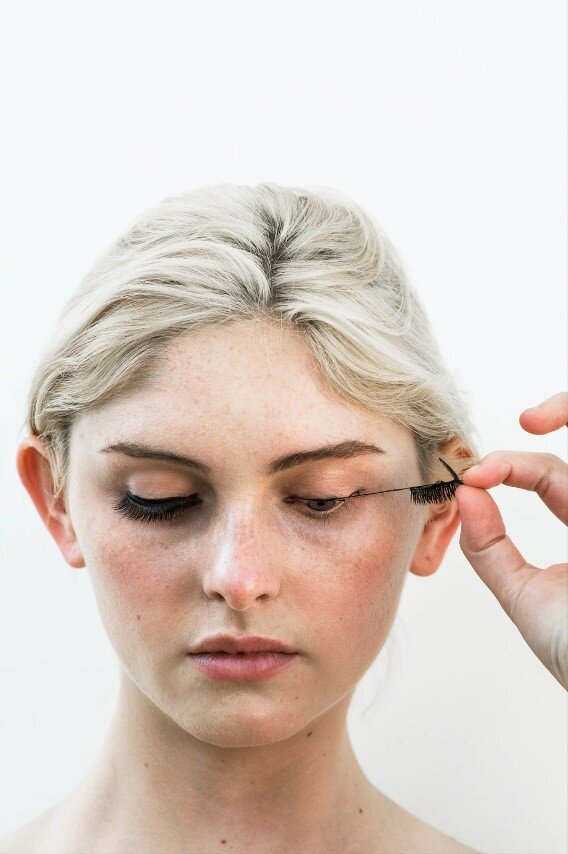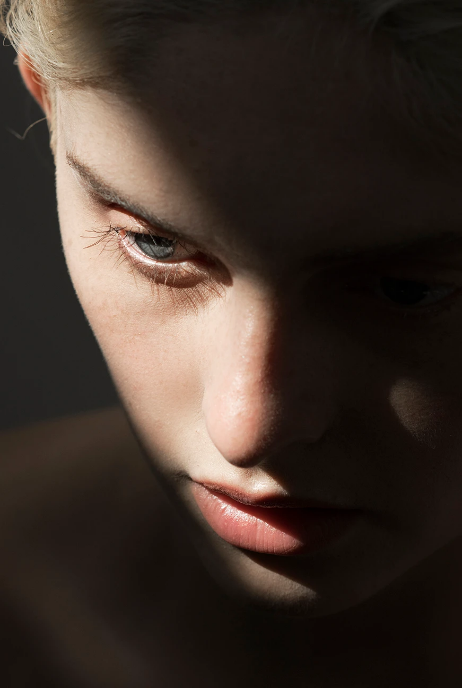Hair Puller Turned Model
Anna Moore, model and compulsive hair puller, went from insecure to incredibly fierce.
I was 5 years old when I began pulling out my eyelashes. I didn’t understand why I liked it, I just knew it made me feel better and that it didn’t hurt. One day my Kindergarten teacher, Mrs. Jeanie, found my eyelashes scattered around my desk. In bewilderment, she exclaimed “Stop, don’t do that!” But I kept plucking. My mom picked me up from school and at the first stop sign, she looked at me, horrified and confused. My mom gasped, “Anna! Where are your eyelashes?” “I pulled them out, Momma. They make a popping noise when I pull them out.”
My mom cried many nights about a condition neither of us could understand. I later learned it had a name: trichotillomania, a hair pulling disorder which affects 4% of the world’s population with a 3:1 female to male ratio.
(Cont’d)
I am 21 now but it’s still hard to explain my hair pulling disorder. There is no cure. Trichotillomania is a genetic disorder.
My grandmother also had trich. When I was 7, my mom was telling my grandmother how I’d been pulling out my eyelashes. “Spanking her doesn’t work! Taking away toys or TV doesn’t work either,” she said. My grandmother replied, “I have the same condition. Anna got the hair pulling condition from me.”
My mom had been searching for years, but the answer was in my blood. My grandmother had been wearing wigs, false eyelashes, had her eyebrows tattooed on to hide the condition. No one ever noticed. She had kept it a secret for her entire life (like so many others with trichotillomania do) until she realized her granddaughter was dealing with the same condition.
My grandmother’s vulnerability changed my parent’s opinion about the condition. With this new information they went to my doctor and he surveyed me to see if I was suffering from adolescent depression. I wasn’t, I was happy; I just handled positive and negative stress factors in my life differently than other kids.
Having trichotillomania during elementary school was tough. Other kids would look closely at my eyes and ask, “Why don’t you have eyelashes?” or “You look funny!” But I can’t blame their curiosity. Something was different about me, and my peers wanted to know why.
My parents congratulated me when I’d let my hair grow and scold me when I’d pull. My doctor explained to them that positive and negative reinforcement wasn’t a healthy way of supporting me as I fluctuated with trichotillomania.
In middle school and high school, I was so involved in sports that I wasn’t too concerned about lack of hair. I experimented with make-up and with a swipe of eyeliner, I realized my hair loss was hardly noticeable. I simply wore false eyelashes when it was really evident I had no lashes.
Then, to my surprise, I was scouted for modeling! I’d never considered modeling, even though I was told I had the face and height for it. I decided to drop my pitching lessons and basketball camps to give it a try.
Towards the end of my freshman year of high school, I signed with Alexandri Models from Russia. I was asked to sign a contract to work internationally in China so my parents set me up with online classes, and I began studying at home and was ready to model abroad.
I went to my agent’s home in Seattle to talk about my first international trip but when I showed up without makeup on, she asked where my eyelashes were. “You cannot go to China with your eyes looking like that!” I was devastated. For months, I’d been dieting to have perfect body measurements and now my face wasn’t good enough?
I felt ill. Like I had a disease that would prevent me from being a successful model. My contract was postponed until my eyelashes grew back. No pressure, right?
While I waited for my hair to re-grow, I created a YouTube channel. I talked about having trich. That video has 127K views and hundreds of comments. I was shocked when it began picking up traction. So many people from all over the world wanted to have a conversation about pulling their hair. I wasn’t alone.
I kept making videos which helped my eyelashes grow back completely. Then I left for China.
Modeling in China was awesome yet I plucked my eyelashes while there. I bought some natural looking false eyelashes and kept going to auditions wearing them. None of the designers cared that I came to work without eyelashes. I was comforted by the makeup artists who told me, “Don’t worry about it!” They would simply apply eyeliner and fake lashes! I walked runway shows during Shanghai Fashion Week. Major makeup artists like MAC, Bobbi Brown, and Estée Lauder never made me feel like an alien. Some even liked my look without eyelashes and one designer from Kipling even used my face for the campaign because I looked beautiful and different!
(continued)
Then I went to work in Greece, where agents were harsh about my hair pulling disorder. They would laugh at me and tell me eyelashes were a feminine feature, and without them, “I’m not sure why you’re here.” I cried when I got home. I showed up on set at L’Oréal Greece and was shunned by the makeup artist. She told me I was “disgusting” and she refused to work with me. The hair stylist ended up doing my makeup and I held back tears the entire shoot. I felt so ugly and embarrassed.
I questioned my entire decision to model and wondered if I should have gone down another life path.
(Cont’d)
The next few years I had a slew of agents who made me feel bad for the way I looked. My hair pulling disorder, my weight, it was always something. I promised myself I would never sign with anyone who made me feel bad about the way I looked ever again.
In my spare time, I made more videos on YouTube related to hair pulling. Maybe my purpose was in sharing something so vulnerable where others could relate. There were still thousands of people needing a voice and a space to open up about this rarely talked about disorder. The response was overwhelming. Things were looking up.
(Continued)
Then, a friend who worked for VICE in Colombia wanted to do a mental health interview with me and shoot me bare-faced! I agreed. It went so well and reached thousands of people and gave me the confidence to be a voice for trichotillomania. The English version is here.
I’m not currently modeling, but am still signed with Alexandri Models in Russia and want to continue making videos about trichotillomania in 2020. My boyfriend adds so much light to my life when I am feeling discouraged and to my surprise (and to show how common this is), he and his dad also have trichotillomania. I told them there’s a name for his habit of pulling out their hair and they were shocked it’s an actual condition. It’s so comforting that my boyfriend can understand it at such a deep level and I have no need to feel ashamed when I’m with him.
I’m currently struggling with my hair pulling as I write this but I’m grateful for a platform to share the ups and downs. I enjoy being an advocate in the beauty and fashion community, but as much as I like to dress up and wear full, long lashes, I love wiping all of it off at the end of the day and being my natural self. That’s when I feel most beautiful.
I hope you know you’re beautiful—with or without hair. Trichotillomania does not make you ugly or weak. It makes you stronger and more beautiful by being more accepting of yourself and others. We all have struggles and you are never alone.
Photo Credits (except childhood photo): Photographer: Manuela Montañez and Makeup: Piper Von Hoene














